Developments after 1800
- Key People:
- Prince
- Brian Eno
- Yanni
- Herbie Hancock
- Billy Preston
- Related Topics:
- eschiquier
- harpsichord family
- celestina
- Geigenwerck
- keyboard
Because of the increasing interest in orchestral and operatic music, the organ fell out of favour during the 18th century, and by 1800 it survived only as an ecclesiastical drudge. From the middle of the 19th century, however, a revival took place under the leadership of two great builders, Aristide Cavaillé-Coll of France and Henry (“Father”) Willis of England. In Britain during the first half of the 19th century, the introduction of pedals made it possible for the first time to play the organ music of J.S. Bach and his German contemporaries and predecessors. While retaining respectable vestiges of the classical chorus, Cavaillé-Coll and Willis developed the solo stops, especially reeds, and Willis, in particular, provided new aids to registration.
Organists found that they could play effective arrangements of orchestral music on the new romantic-style organ. Since orchestral music was popular and respectable orchestras very rare and other forms of public entertainment even more so, the organ suddenly regained an immense popularity hardly rivaled by that of the 17th and 18th centuries, when it was the acknowledged “king of instruments.” Organ builders naturally responded by making their instruments increasingly orchestral in character, culminating at the end of the 19th century in the work of the English builder Robert Hope-Jones, who entirely abandoned the chorus and mutation stops and relied instead upon diapasons of vast scale on high-pressure wind, with reeds to match, backed up by huge-scaled flutes, tiny-scaled string stops (with keen-sounding flue pipes), and powerful stops of his own invention called diaphones. Hope-Jones emigrated to the United States, and, although a semblance of classical design returned to Britain soon after 1900, his influence continued to be felt throughout the first half of the 20th century. This trend toward orchestral imitation discredited the organ as a musical instrument in the eyes of serious musicians and composers.
The first organs in Britain’s American colonies had been imported from England beginning about 1700. This was the period of the English Commonwealth, and the Puritan view of the “unsuitability” of an organ in church was inherited by the colonies. Only parishes of the Church of England (later known as the Protestant Episcopal Church) and Lutheran and Moravian churches in Pennsylvania would admit instruments. Another century elapsed before the New England Puritans did likewise. The only 18th-century builder of note was the German-American David Tannenberg. Prominent American builders of the 1800s included Henry Erben, Elias and George Hook, George Jardine, William A. Johnson, J.H. and C.S. Odell, and Hilborne and Frank Roosevelt. Perhaps the inevitable end of the U.S. “romantic” era was reached in Ernest M. Skinner, who lived until the middle of the 20th century. In Canada, Joseph Casavant built his first organ in Quebec province in 1837. Two of his sons visited France in 1878–79 and brought back to North America the Cavaillé-Coll tradition.
Albert Schweitzer, organist, philosopher, and later medical missionary, wrote a booklet, Deutsche und französische Orgelbaukunst und Orgelkunst (“The Art of German and French Organ Builders and Players”), in 1906 outlining the inadequacies of the 19th-century organ for the performance of the music of J.S. Bach and his contemporaries. It was not until 1926, however, with Karl Straube, that the revival of 18th-century and earlier styles of organ building began. Straube, organist at Bach’s Tomas Church in Leipzig, noted editor of Baroque organ works, and leading exponent of the Romantic works of Max Reger, renounced the Romantic approach to the organ and called for a return to Baroque principles. Certain historically minded organ builders in Germany, soon followed in other European countries and in North America, heeded Straube’s call by constructing instruments based tonally and structurally upon Baroque models and by restoring old but altered tracker-action organs to their original specifications. While even the best of such specialized organs may not accommodate large-scale works by Romantic and later composers, their musical qualities and sensitivity to the player’s touch render them artistically superior to unwieldy all-purpose organs, some of which have more than 150 ranks.
The late 20th century has seen a decline in production of pipe organs, with several large manufacturers going out of business in the United States. However, small firms building highly refined tracker-action instruments have proliferated. Increasingly, their organs adopt tuning systems other than equal temperament, pitches higher or lower than usual, short-octave keyboards, and other retrospective features that allow performers to re-create organ music of the 16th through 18th centuries in ways that would have been familiar to composers of those times.
The reed organ
The term reed organ normally refers to a keyboard instrument in which sound is produced by free reeds. Accordions and concertinas are examples of small, hand-held reed organs. Free reeds are thin, flexible strips of metal, usually brass, that are secured at one end over or under close-fitting openings in plates that are mounted over a wind-chest. Suction or wind pressure causes the free end of the reed to vibrate in and out of its aperture when its key is depressed to open a valve, or pallet, in the wind-chest. The pitch of each reed is determined by its length, though tuning can be accomplished by thinning or weighting the reed. No resonator is required to modify the tone quality, which is affected chiefly by the shape, thickness, resilience, and curvature of the reed.
It is not known when the free reed was first introduced to Europe from Asia, where as early as 1100 bc free reeds were incorporated into mouth organs such as the Chinese sheng. The sheng itself was known in Europe by 1777, by which time free reeds had already appeared in experimental organs. The tuning stability, small size, and low cost of free reeds were quickly recognized as virtues, and by the early 19th century small organs using free reeds in place of or in addition to pipes and with bellows pumped by the player’s feet were being manufactured in Europe and the United States. Occasionally free reed stops appeared as an adjunct to pianos and in mechanical instruments such as Johann Nepomuk Maelzel’s panharmonicon, first exhibited in Vienna in 1804.
Because of their simplicity, portability, and ease of maintenance, by the mid-19th century reed organs had become popular domestic instruments, rivaling the piano in numbers though not in quality or quantity of repertoire. In churches and other institutions, especially less affluent ones in rural areas, reed organs with up to three manuals, a pedal keyboard, and five or more sets of reeds often served in place of costlier pipe organs. The versatile and expressive harmonium (a compact reed organ patented in 1842 by the Frenchman Alexandre-François Debain and later developed by others) attracted the efforts of major composers such as Antonín Dvořák and Cesar Franck.
While European reed organs generally operated with wind under pressure (supplied by feeder-bellows), a type that employed suction to sound the reeds was developed in the United States, notably in New England, where seraphines, lap organs, and melodeons (as some varieties were called) were patented and manufactured in great numbers after about 1830. In 1847, Emmons Hamlin, an employee of the George A. Prince melodeon factory in Buffalo, N.Y., greatly improved the tonal quality of free reeds by bending them in various ways; the Boston firm that Hamlin founded with Henry Mason in 1854 became an international leader in producing “cabinet organs” of modest size.
Although reed organs continued to be manufactured into the 20th century and were occasionally employed in ensemble music by serious composers such as Arnold Schoenberg and Kurt Weill, they suffered from defects such as sluggish response, cloying tone, and limited expressive capability. In the face of unrelenting competition from cheap upright pianos (which they often resembled in appearance) and, later, from electronic instruments, reed organ production declined in the second quarter of the century, though fine old examples in playable condition remain numerous. Production of small reed organs has continued in India, where they provide drone accompaniments for, for example, sitar music.








